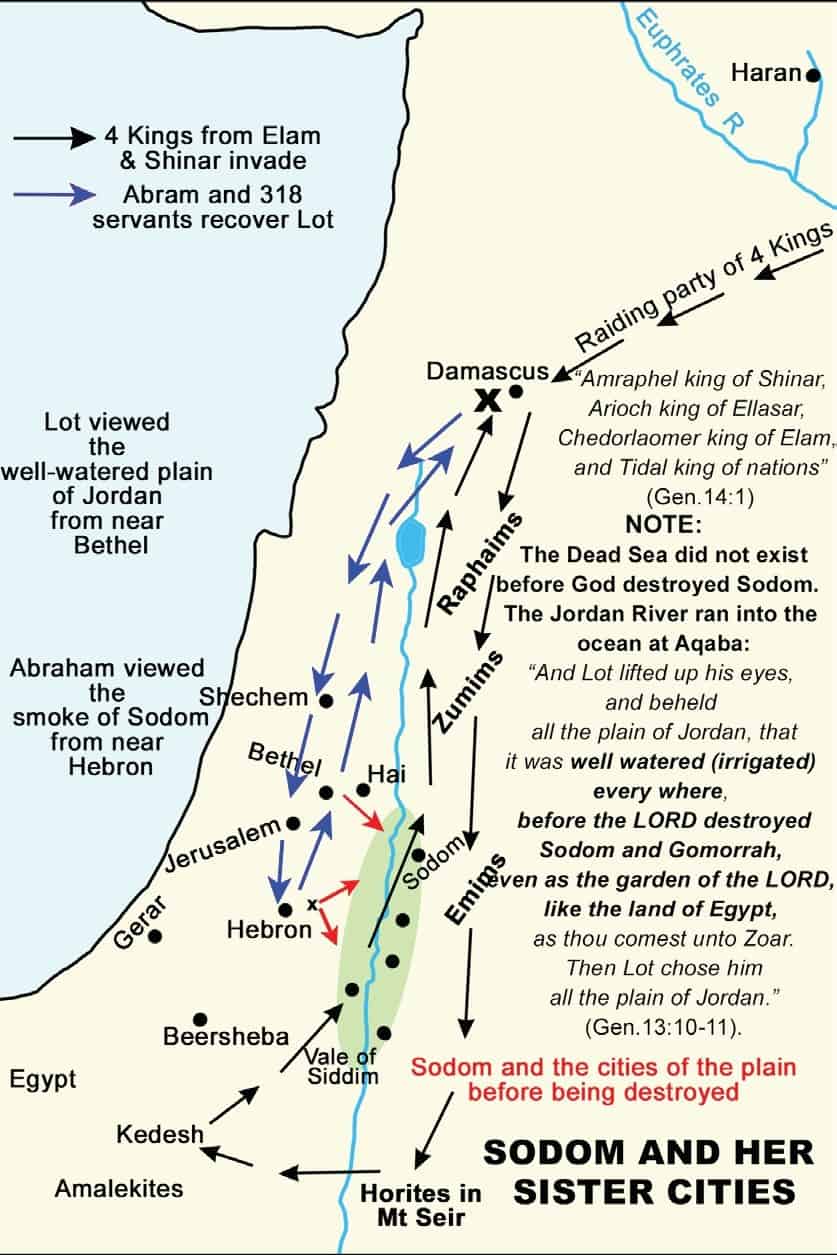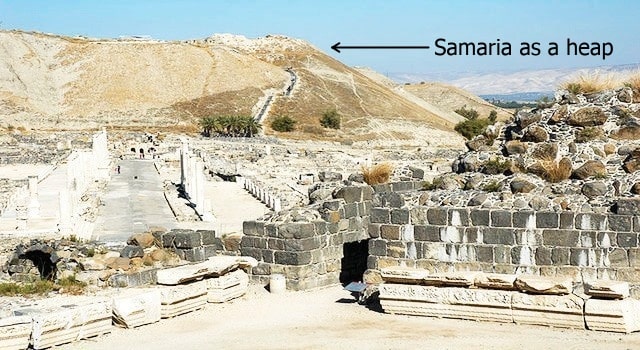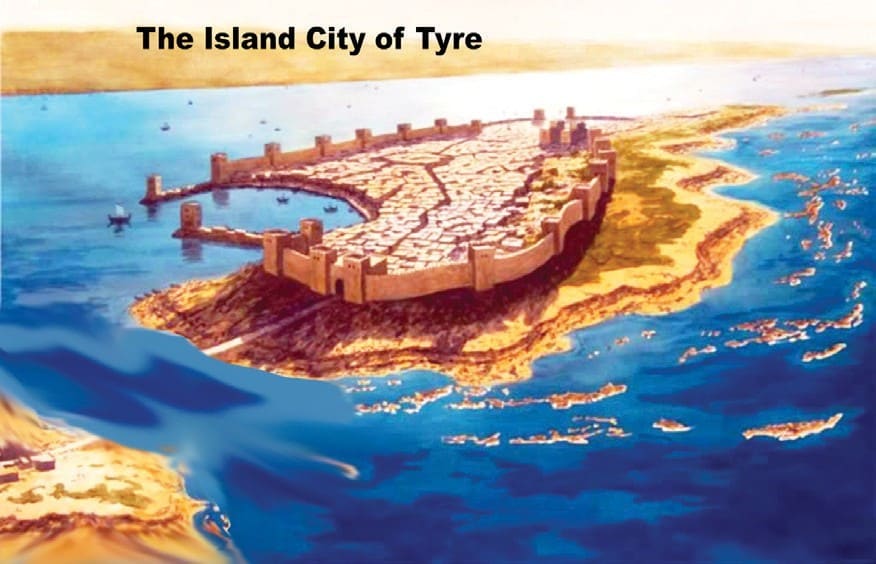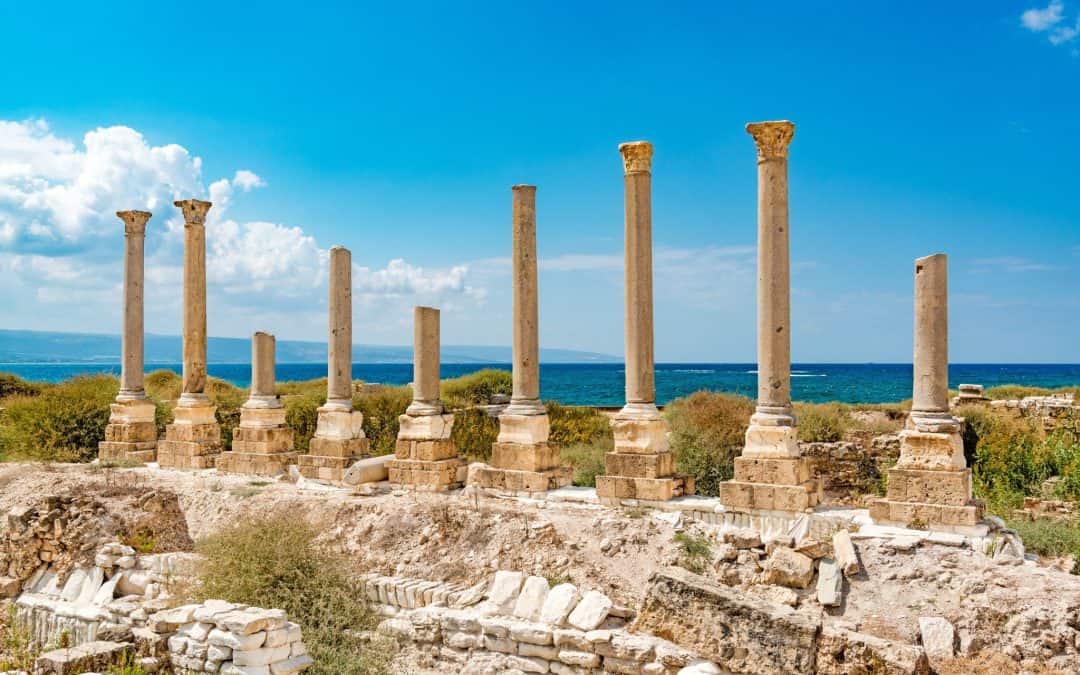The ruins at the city of Tyre in modern day Lebanon.
About the year 2010 a father asked me to speak to his son who was having difficulty believing that there was a God. My answer was very simple. The Bible.
The Bible claims to be the words of the Living God and when this is shown to be true then there must be a God who created all things to whom we must give account for our behaviour. If the God of the Bible is the Living God then He must be omniscient, omnipotent, omnipresent. Since He is a loving God and wants all men to be saved from sin, we would expect that He would give us good reasons to believe that “He is, and that He is a rewarder of them that diligently seek Him” (Hebrews 11:6).
God has given us tangible evidence of Himself that is well documented and can be easily verified. One line of evidence is found in fulfilled prophecies of cities that were once major centres of opposition to God but which were destroyed to be examples to future generations. The manner in which these cities were destroyed indicates that God is longsuffering and always gives opportunity to repent before judgment falls. The record of these cities is indisputable in the annuls of history and their remains bears testimony today. The cities we refer to are:
- Sodom
- Nineveh
- Samaria
- Babylon
- Tyre
- Jerusalem
1. Sodom

Sodom and her Sister Cities
Sodom was blessed by God with lush pastures in the irrigated “plain of Jordan” which was “well watered everywhere”. It was located to the north of the plain of Siddim where there were abundant supplies of bitument described as “slimepits” that could be used in building construction. Five cities had been built on the banks of the freshwaters that flowed down from the snowcapped Mount Hermon to the Gulf of Aquaba giving access to the sea. The Bible states of
all the plain of Jordan, that it was well watered every where, before the LORD destroyed Sodom and Gomorrah, even as the garden of the LORD, like the land of Egypt (Genesis 13:10).
Sodom’s prosperity could be compared with that of Egypt.
Ezekiel tells us that
Behold, this was the iniquity of thy sister Sodom, pride, fulness of bread, and abundance of idleness was in her and in her daughters, neither did she strengthen the hand of the poor and needy. And they were haughty, and committed abomination before me: therefore I took them away as I saw good (Ezekiel 16:49-50).
The idyllic conditions in the plain of Jordan were likened to the garden of the Lord (Eden) and they had given the people much free time to indulge in the pleasures of life; they lost their good hard working ethic and and became arrogant so much so, that they boldly and unashamedly practiced immoral homosexual behaviour.
God’s first response was to send armies led by four kings from Mesapotamia to fight against Sodom and her associates. At first, these marauders passed by on the east of the cities of the plain travelling south then they turned west across to Kedesh in the Negev and finally swung north to approach Sodom and her cities from the south.
The King of Sodom rallied his troops and went south to meet the invading army in the Valley of Siddim where a battle was fought and the armies of Sodom was soundly defeated; many were taken captive and the cities of the plain spoiled.
Among those taken captive was Abraham’s nephew, Lot, and soon they were on their way home to live a life of slavery when Abraham armed his 318 servants and caught the marauders near Dan, attacking them at night and then pursuing them as far as Damascus.
God was giving Sodom a solemn warning and an opportunity to amend their ways in true repentance but to no avail. The rescue of the men of Sodom indicates the mercy of God for He delights in mercy and is longsuffering “not willing (desirous) that any should perish” but that all should come to repentance.
Years passed and Sodom showed no signs of repentance in spite of the mercy extended by God to her and so God sent 2 angels to Sodom to rescue Lot before His fiery judgment fell on all the cities of the plain. So great was this judgment that the entire region sank more than 1,200 feet to become the lowest place on the face of the globe. The fire that went up from the plain of Jordan was witnessed by Abraham from the mountain near Hebron and he described the smoke “as the smoke of a furnace” (Genesis 19:28). God rained “brimstone and fire” upon those wicked cities and nobody but Lot and his daughters escaped.
The evidence is in the Dead Sea today and the entire topography of the Jordan valley is testimony to the destruction of Sodom. The Dead Sea is 1,200 feet below sea level and is the lowest point on earth. The plain of Jordan that was formerly like “the garden of the LORD, like the land of Egypt” (Genesis 13:10) is now a sea that is so toxic that no life can survive in it and if humans swallow any quantity of it they would die. The topography of the Jordan valley is stark evidence that the Biblical record is true and that there is a God in heaven.
2. Nineveh

The City of Nineveh
When Babylon was being built by wicked Nimrod, Asshur from the Godly line of Shem left the land of Shinar and built Nineveh evidently in protest. Modern versions have loosely translated Genesis 10:11 to accommodate the 1762 archeologist, Carsten Niebuhr who renamed the city of Calah as Nimrud because he mistakenly thought that Nimrod built Nineveh and the surrounding cities.
All ancient records identified the city as Calah, and the Greek Septuagint, the Book of Jubilees, the historian Josephus and the Geneva Bible all agree with the King James Bible translation which states that “out of that land (Shinar) went forth Asshur (from the line of Shem) and built Nineveh…” and her sister cities. The Encyclopedia Wikipedia also agrees.
Nineveh had a Godly beginning but became violent and wicked about 800BC when God sent Jonah to warn them to repent or be judged within 40 days. The city hearkened to Jonah, returned to the Lord in true repentance, and God mercifully spared the city.
About 80 years later the Assyrian army was sent by the Lord to punish the northern kingdom of Israel to take the ten tribes away captive into the land of the Medes. Flush with the victory over Samaria the next King of Assyria, Sennacherib, came just a few years later, into the land of Judah and his agent, Rabshakah stood outside the walls of Jerusalem and mocked the God of Israel. The angel of the Lord slew 185,000 Assyrians in one night.
The prophet Nahum foretold this event. He wrote:
There is one come out of thee (Nineveh), that imagineth evil against the LORD, a wicked counsellor… the LORD hath given a commandment concerning thee, that no more of thy name be sown: out of the house of thy gods will I cut off the graven image and the molten image: I will make thy grave; for thou art vile (Nahum 1:11-15).
In 612BC the Babylonian armies under Nebuchadnezzar and the armies of the Medes came against Nineveh and the impregnable city was destroyed after flooding had caused much of the wall along the Tigris River to collapse. The king burned the palace down over himself exactly as the prophet Nahum had foretold. So complete was the destruction of Nineveh that 270 years later, Alexander the Great marched over the site and did not know that Nineveh was under his feet.
Today Nineveh has been excavated and the royal palace with the great Assyrian library of Ashurbanipal has yielded tens of thousands of documents in clay tablets and in stone stela which are on display in museums around the world.
3. Samaria
Samaria was the capital of the northern Kingdom of Israel and in the days of Jeroboam they turned to idolatry, worshipping two golden calves.
These tribes were part of the nation of Israel that God brought out of Egypt and to whom God had given His law. Yet in the days of Rehoboam the son of Solomon, Jeroboam set up the golden calves that led the ten northern tribes into idolatry.
Elijah and Elisha prophesied against this wickedness and when Ahab was king even the compromising Jehoshaphat witnessed to Ahab. On Mt Carmel God showed His power with fire from heaven that consumed Elijah’s sacrifice, the people cried, The Lord, he is the God and 850 of Jezebel’s prophets were slain. Israel had the opportunity to repent but they continued in idolatry and God said
Therefore I will make Samaria as an heap of the field, and as plantings of a vineyard: and I will pour down the stones thereof into the valley, and I will discover the foundations thereof (Micah 1:6).
God waited 200 years before He sent the Assyrians under Shalmanezar and Sargon to take Samaria and today Samaria is a heap, a Tell, visible to all who pass by.

Babylon was built by Nimrod as a centre of idolatry and God confused the languages of all who worked on the Tower of Babel. Throughout the centuries Babylon was the mother of idolatry and the gods of Babylon were worshipped under different names by many nations.
Nevertheless God gave Babylon opportunity to repent and in the days of Nebuchadnezzar Daniel and Ezekiel witnessed in Babylon to her. At the same time Jeremiah wrote:
We would have healed Babylon, but she is not healed: forsake her, and let us go every one into his own country: for her judgment reacheth unto heaven, and is lifted up even to the skies (Jeremiah 51:9).
 God gave Babylon great victories over Assyria, Elam and Egypt besides many smaller nations and the Babylonian Empire was the first to have universal control.. God called Nebuchadnezzar “My servant” for executing Divine judgment against the nations for their wickedness and He gave him all the riches of Egypt in 570BC for the service he rendered to God against Tyre (Ezekiel 28:18-19). King Nebuchadnezzar finally professed faith in the Living God at the end of his reign yet 30 years later the city of Babylon under Belshazzar continued in sin and drank wine to heathen gods using the golden vessels from the Temple of God in Jerusalem.
God gave Babylon great victories over Assyria, Elam and Egypt besides many smaller nations and the Babylonian Empire was the first to have universal control.. God called Nebuchadnezzar “My servant” for executing Divine judgment against the nations for their wickedness and He gave him all the riches of Egypt in 570BC for the service he rendered to God against Tyre (Ezekiel 28:18-19). King Nebuchadnezzar finally professed faith in the Living God at the end of his reign yet 30 years later the city of Babylon under Belshazzar continued in sin and drank wine to heathen gods using the golden vessels from the Temple of God in Jerusalem.
God said that “Babylon shall become heaps, a dwelling place for dragons, an astonishment, and an hissing, without an inhabitant” (Jeremiah 51:37) and today Babylon is an archeological site with no inhabitant. The treasures from Babylon may be found all over the world in Museums and libraries.
So serious was Babylon’s sin that God said the city would be destroyed and never be rebuilt; it would be uninhabited like Sodom. The initial overthrow of Babylon by the Medes and Persians was foretold and about 170 years beforehand, Cyrus was named by Isaiah as the Persian King that would conquer the city (Isaiah 44:28 and 45:1). The history of Babylon in the Bible is proof that the God of the Bible is the only Living God.
4. Tyre
Tyre and her sister city Sidon were judged by the Lord but there was a time when Tyre knew the Lord. Hiram King of Tyre was “ever a lover of David” (1 Kings 5:1) and rejoiced that Solomon would build the Temple saying, “Blessed be the LORD this day, which hath given unto David a wise son over this great people” (1 Kings 5:7). Hiram assisted Solomon in building the Temple at Jerusalem (1028BC) yet Ezekiel foretold Tyre’s destruction in two stages. Tyre had the opportunity to follow the Lord but turned away and became the centre of Satan’s throne as described in Ezekiel 28:11-19. The King of Tyre was actually possessed by Satan (Ezekiel 28:11-19).

The Island City of Tyre

Island City of Tyre – Map
First, God said the coastal city would be destroyed by Nebuchadnezzar (Ezekiel 26:7) and later the Island city would be destroyed. Alexander the Great destroyed the Island city and the walls of the island were broken down. The coastal city was scraped “like the top of a rock” (Ezekiel 26:14) and became a place for fishermen to spread their nets just as Ezekiel prophesied:
And they shall destroy the walls of Tyrus, and break down her towers: I will also scrape her dust from her, and make her like the top of a rock. It shall be a place for the spreading of nets in the midst of the sea: for I have spoken it, saith the Lord GOD (Ezekiel 26:4-5).
Nebuchadnezzar destroyed Tyre’s coastal city after a 13-year siege beginning in the 7th year of his reign concluding in 586BC. Alexander the Great destroyed the Island city in 332BC. He scrapped the rock bare and pushed the remains of the coastal city into the sea to make a causeway to the island city which he conquered and destroyed. Tyre is another example of the mercy and longsuffering of God but also of His righteous judgment.
6. Jerusalem
Jerusalem was a blessed city where God placed His name. The Temple was built there and sacrifices offered daily to the Lord. No city was more privileged than Jerusalem yet its destruction took place, first in the time of Nebuchadnezzar in 586BC and again in AD70 and AD135. The Palestinian covenant promised that the Jews would be judged and scattered if they disobeyed the Lord. In the time of Jeremiah, Nebuchadnezzar came and took Israel captive. Jerusalem was left in ruins for 140 years until Nehemiah returned and began to rebuild in 445BC. It was rebuilt in 49 years according to Daniel’s prophecy (Daniel 9:25).
When Jesus came He was rejected by the nation and God again destroyed the city in fulfilment of His words:
O Jerusalem, Jerusalem, which killest the prophets, and stonest them that are sent unto thee; how often would I have gathered thy children together, as a hen doth gather her brood under her wings, and ye would not! Behold, your house is left unto you desolate. (Luke 13:34-35)
His disciples came to him for to shew him the buildings of the temple. And Jesus said unto them, See ye not all these things? verily I say unto you, There shall not be left here one stone upon another, that shall not be thrown down. (Matthew 24:1-2)
In AD 70 the Romans under Titus destroyed the Temple but the Jews revolted again in the reign of Emperor Hadrian (132 – 135 AD) and many Jews returned to the land to fight against the Romans. Over half a million Jews perished and the Roman commander Turnus Rufus plowed the site of the Temple in Jerusalem and the surrounding area in 135 AD in fulfilment of Micah’s prophecy: “Zion for your sake be plowed as a field, and Jerusalem shall become heaps, and the mountain of the house as the high places of the forest.” (Micah 3:12).

Roman coins showing Hadrian plowing the first furrow at Jerusalem
Jeremiah quoted Micah’s prophecy (Jeremiah 26:18) about 115 years later as he faced the Babylonian invasion but it was not filfilled until the Roman invasion by Hadrian who established a Roman colony on the site of the destroyed city of Jerusalem calling it Aelia Capitolina because he dedicated the city to Jupiter Capitolinus.
In the Grecian era Antiochus Epiphanes had placed an image of Zeus in the Temple and this sparked the Maccabean Wars concluding with the cleansing of the Temple which is remembered each year at the Feast of Dedication (in 2018 it was from 2 Dec. to 10 Dec.). The Romans regarded Jupiter as the equivalent of the Greek Zeus.
Hadrian placed his soldiers in Aelia Capitolina and Jews were forbidden to enter the city except on one day each year to commemorate the destruction of the Temple – Tisha B’av on the 9th of the month Av. On this day the Jews fast and read the Book of Lamentations. In 2018 it fell on 9th August.
Constantine (4th C) built Christian churches in Jerusalem and the Church of the Holy Sepulchure was built over the site of what was thought to be Christ’s Tomb but Gordon’s Calvary is the real location.
According to the Mishnah (Taanit 4:6), five specific events occurred on the ninth of Av that warrant fasting:
- The Twelve Spies sent by Moses to observe the land of Canaan returned from their mission. Only two of the spies, Joshua and Caleb, brought a positive report, while the others spoke disparagingly about the land. The majority report caused the Children of Israel to cry, panic and despair of ever entering the “Promised Land”. For this, they were punished by God that their generation would not enter the land. The midrash quotes God as saying about this event, “You cried before me pointlessly, I will fix for you [this day as a day of] crying for the generations”, alluding to the future misfortunes which occurred on the same date.
- The First Temple built by King Solomon was destroyed by Nebuchadnezzar in 587 BCE, and the population of the Kingdom of Judah was sent into the Babylonian exile.[6] The First Temple’s destruction began on the 7th of Av (2 Kings 25:8) and continued until the 10th (Jeremiah 52:12). According to the Talmud, the actual destruction of the Temple began on the Ninth of Av, and it continued to burn throughout the Tenth of Av.
- The Second Temple built by Ezra and Nehemiah was destroyed by the Romans in 70AD scattering the people of Judea and commencing the Jewish exile from the Holy Land that continues to this day.
- The Romans subsequently crushed Bar Kokhba’s revolt and destroyed the city of Betar, killing over 500,000 Jewish civilians (approximately 580,000) on August 4, 135 AD.
- Following the Bar Kokhba revolt, Roman commander Turnus Rufus plowed the site of the Temple in Jerusalem and the surrounding area, in 135 AD. (The coin shows Hadrian plowing the first furrow.)
Conclusion
Quite apart from many other evidences that there is a God in heaven who created the world and to whom we must answer, these cities stand out in history as undeniable evidence of an omnipresent, omnipotent and omniscient God who knows the future and has given us His Word to record the prophecies. The Bible therefore is proof that our God is the only living God.
The message of these cities is consistent. In every case they had opportunity to be blessed but when they persisted in evil they came under the foretold judgments.
Sodom was rescued by Godly Abraham before it was judged; Samaria had the testimony of Elijah and 850 false prophets were slain before God sent the Assyrians to destroy the city; Nineveh was spared in Jonah’s day before it was destroyed; Babylon had the testimony of Daniel and Ezekiel and Nebuchadnezzar turned to the Lord before Belshazzar was slain and the city conquered; Tyre was involved in the building of the Temple at Jerusalem and came under David’s testimony before it was ruled by Satan and was destroyed; Jerusalem had three opportunities to make good but was finally destroyed exactly as foretold. Because it is the place where God has put His name we know it will be the focal point of events in the last days and there will be a New Jerusalem in which we will dwell for all eternity.

